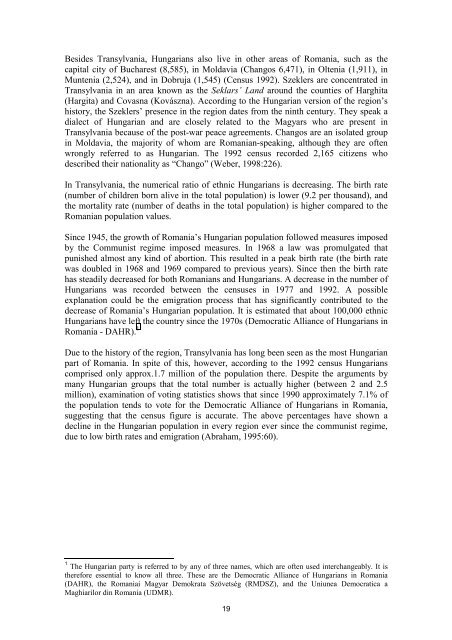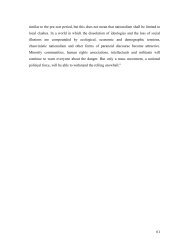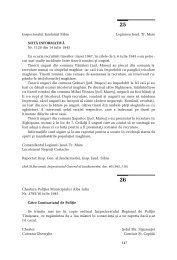Southeast Europe
Southeast Europe
Southeast Europe
You also want an ePaper? Increase the reach of your titles
YUMPU automatically turns print PDFs into web optimized ePapers that Google loves.
Besides Transylvania, Hungarians also live in other areas of Romania, such as the<br />
capital city of Bucharest (8,585), in Moldavia (Changos 6,471), in Oltenia (1,911), in<br />
Muntenia (2,524), and in Dobruja (1,545) (Census 1992). Szeklers are concentrated in<br />
Transylvania in an area known as the Seklars’ Land around the counties of Harghita<br />
(Hargita) and Covasna (Kovászna). According to the Hungarian version of the region’s<br />
history, the Szeklers’ presence in the region dates from the ninth century. They speak a<br />
dialect of Hungarian and are closely related to the Magyars who are present in<br />
Transylvania because of the post-war peace agreements. Changos are an isolated group<br />
in Moldavia, the majority of whom are Romanian-speaking, although they are often<br />
wrongly referred to as Hungarian. The 1992 census recorded 2,165 citizens who<br />
described their nationality as “Chango” (Weber, 1998:226).<br />
In Transylvania, the numerical ratio of ethnic Hungarians is decreasing. The birth rate<br />
(number of children born alive in the total population) is lower (9.2 per thousand), and<br />
the mortality rate (number of deaths in the total population) is higher compared to the<br />
Romanian population values.<br />
Since 1945, the growth of Romania’s Hungarian population followed measures imposed<br />
by the Communist regime imposed measures. In 1968 a law was promulgated that<br />
punished almost any kind of abortion. This resulted in a peak birth rate (the birth rate<br />
was doubled in 1968 and 1969 compared to previous years). Since then the birth rate<br />
has steadily decreased for both Romanians and Hungarians. A decrease in the number of<br />
Hungarians was recorded between the censuses in 1977 and 1992. A possible<br />
explanation could be the emigration process that has significantly contributed to the<br />
decrease of Romania’s Hungarian population. It is estimated that about 100,000 ethnic<br />
Hungarians have left the country since the 1970s (Democratic Alliance of Hungarians in<br />
Romania - DAHR). 1<br />
Due to the history of the region, Transylvania has long been seen as the most Hungarian<br />
part of Romania. In spite of this, however, according to the 1992 census Hungarians<br />
comprised only approx.1.7 million of the population there. Despite the arguments by<br />
many Hungarian groups that the total number is actually higher (between 2 and 2.5<br />
million), examination of voting statistics shows that since 1990 approximately 7.1% of<br />
the population tends to vote for the Democratic Alliance of Hungarians in Romania,<br />
suggesting that the census figure is accurate. The above percentages have shown a<br />
decline in the Hungarian population in every region ever since the communist regime,<br />
due to low birth rates and emigration (Abraham, 1995:60).<br />
1 The Hungarian party is referred to by any of three names, which are often used interchangeably. It is<br />
therefore essential to know all three. These are the Democratic Alliance of Hungarians in Romania<br />
(DAHR), the Romaniai Magyar Demokrata Szövetség (RMDSZ), and the Uniunea Democratica a<br />
Maghiarilor din Romania (UDMR).<br />
19









